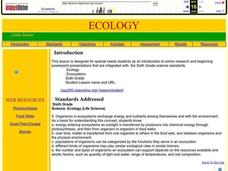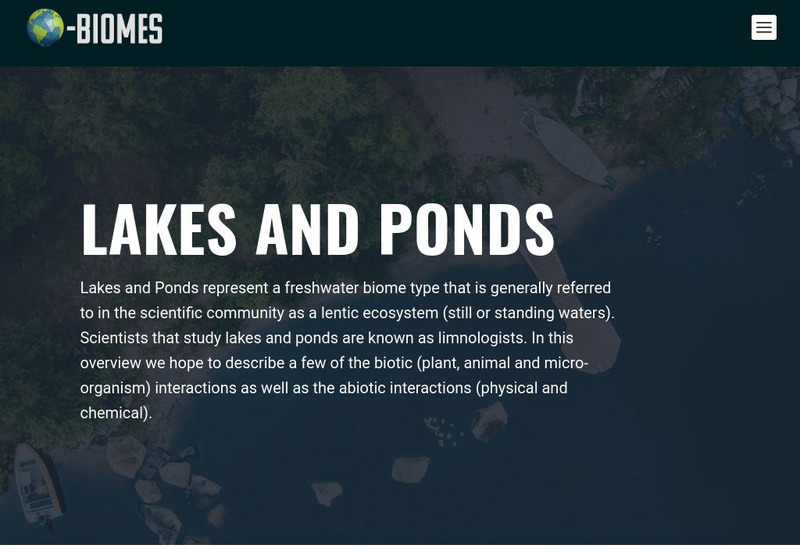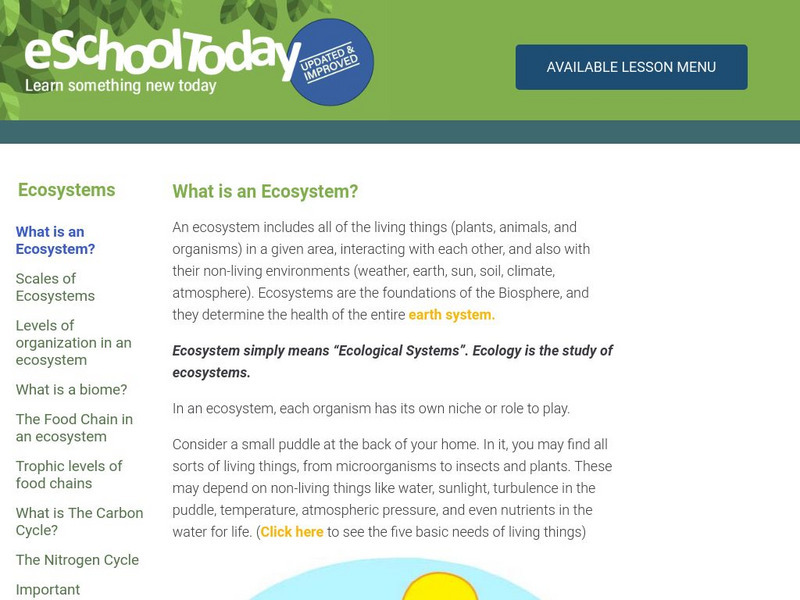Curated OER
Estuarine Habitats
Sixth graders study the important habitats, flora, fauna, and physical factors of coastal habitats. They compare the aquatic habitats to terrestrial habitats by researching and completing tables with the information.
Curated OER
Ecology
Sixth graders are introduced to online research and beginning PowerPoint presentations that are integrated. They pass a plant and photosynthesis. Students locate information on a self selected animal online. They give a PowerPoint...
Curated OER
Six Levels of Ecological Organization
Ninth graders describe the six levels of ecological organizations and give examples of each. They also differentiate between food chains and webs and identify trophic and consumer levels in food chain and food webs.
Curated OER
Commonalities and Differences from Africa to Cleveland as Evidence Through the Gullah Community Connection
Students explore Afro-American history. They identify the commonality between African, Carolinian and Cleveland Black culture. Students explore the water cycle, oceanography, hydrology and bio-geochemical processes. They discuss the...
Curated OER
HyperStudio Animal Project
Fourth graders create a HyperStudio project on an animal of their choice. They discuss the animal's habitat and adaptations. They also identify any interesting facts about their animal.
Curated OER
Art of Biodiversity
Learners familiarize themselves with values of biodiversity. They comprehend that biodiversity has inspirational and cultural values. Students locate five works of art on Zoo grounds that represent biodiversity in some way.
The Wild Classroom
The Wild Classroom: Biomes
This excellent resource explores all of the biomes found on planet Earth! A side menu indicates the world's biomes and provides details on each. Colorful interactive maps, video clips, lesson plans, species profiles, and so much more...
Ducksters
Ducksters: Science for Kids: World Biomes and Ecosystems
Kids learn about the world's biomes and ecosystems. The network of life and biodiversity needed for all to survive.
National Earth Science Teachers Association
Windows to the Universe: Biomes and Ecosystems
Are you looking for a good starting place on where to research biomes? This site would be a great place to start as it contains lots of information about all the different biomes on Earth.
Center for Educational Technologies
Center for Educational Technologies: Earth Floor Biomes
This site provides information on the different biomes of the Earth. There are links to related information and other topics.
The Wild Classroom
The Wild Classroom: Biomes of the World: Lakes and Ponds
Learn about lake and pond ecosystems. Find out about plants, animals, adaptations, and conservation efforts.
The Wild Classroom
The Wild Classroom: Biomes of the World: Streams and Rivers
Learn about stream and river ecosystems. Find out about plants, animals, adaptations, and conservation efforts.
The Wild Classroom
The Wild Classroom: Biomes of the World: Estuaries Biome
Learn about estuary ecosystems. Find out about plants, animals, adaptations, and conservation efforts.
eSchool Today
E School Today: What Is an Ecosystem?
Learn about all the different levels of ecosystems, from the living things under a rock, up to a rainforest biome. Explains the levels of organization within an ecosystem, the different types of biomes, food chains and trophic levels,...
Enchanted Learning
Enchanted Learning: Biomes
Discover the hidden treasures in the different habitats on the earth! The earth is filled with many biomes. Examples of different biomes are listed and include hyperlinks to additional information such as the animals found there.
The Wild Classroom
The Wild Classroom: Biomes of the World: Desert Scrub Biome
Learn about the desert scrub ecosystem. Find out about plants, animals, adaptations, and conservation efforts.
Utah Education Network
Uen: Themepark: Systems: Ecosystem
Find a large collection of internet resources organized around ecosystems. Links to places to go, people to see, things to do, teacher resources, and bibliographies.
PBS
Pbs Learning Media: Biomes
This interactive resource adapted from NASA describes the different temperature, precipitation, and vegetation patterns in seven biomes: coniferous forest, temperate deciduous forest, desert, grassland, rainforest, shrubland, and tundra.
Science Buddies
Science Buddies: Home Sweet Biome: How Do Plants Grow in Different Environments?
In this science fair project you will learn about biomes and how different climatic conditions affect plant growth. This can explain why some plants and animals are similar in different areas of the country, and in other parts they are not.
Massachusetts Institute of Technology
Mit: Open Course Ware: Ecology: Communities and Ecosystems
This is a collection of courses on communities and ecosystems. Some topics explored are productivity, food webs, and ecology. The courses offer video clips, lecture notes, practice problems, and exam questions. Practice problems and exam...
Open Curriculum
Open Curriculum: Biomes
This video illustrates the relationship between biomes and climate. [3 min, 38 sec]
CK-12 Foundation
Ck 12: Episd: Freshwater and Wetlands Biomes
[Free Registration/Login may be required to access all resource tools.] A classroom introduction to freshwater ecosystems.
SMART Technologies
Smart: Biome Swatter
This is a quiz game on biomes. Questions are presented as its corresponding bee is swatted.
CK-12 Foundation
Ck 12: Episd: Terrestrial Biomes
[Free Registration/Login may be required to access all resource tools.] Recognize and explore the variety of terrestrial biomes and understand the differences among them.






















